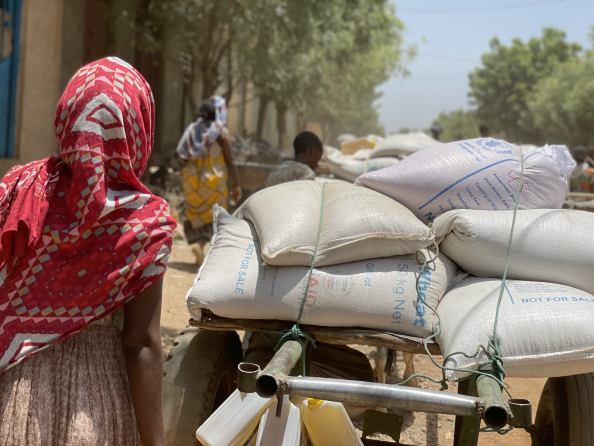WFP Reaches Over 1 Million People with Emergency Food Assistance in Tigray

MEKELE – The United Nations World Food Programme (WFP) has provided emergency food assistance to 1 million people since starting distributions in Northwestern and Southern zones of Tigray region in March.
Aster Beyene, a 43-year-old mother of seven, who lost both her home and crops two months ago to conflict, became the 1 millionth person to collect wheat, split peas and vegetable oil from U.N. World Food Programme on Monday.
“Up until now I have relied on what little food I can get from my neighbors. At least now we have some relief from the hunger we have been suffering,” said Aster from Adi Millen, a remote rural village 31 miles from Shire in Northwestern zone. The U.N. World Food Programme provided food to the 4,500 villagers, bringing the first round of food distributions – which will be carried out every six weeks in Tigray – to a close.
“I am glad that the U.N. World Food Programme was able to bring the food to us here in Adi Millen, where we are far and cut off from many towns and markets,” Aster added.
- The U.N. World Food Programme is responsible for emergency food assistance across Northwestern and Southern zones of Tigray and will scale-up operations to reach 2.1 million people in need of food assistance across these operational areas. Since April, it has managed to access all 13 woredas (districts) of Northwestern and assisted 885,000 people. In addition, U.N. World Food Programme distributions began at the end of March in three woredas of Southern zone where 168,000 people have so far received the U.N. World Food Programme emergency food, bringing the total to 1.05 million people. In March, before the U.N. World Food Programme was assigned Northwestern and Southern zones, the U.N. World Food Programme had assisted 33,000 people in Eastern zone.
- This week, the U.N. World Food Programme kicked off a second six-week round of emergency food assistance, starting in Korem and Ofla, two of five new woredas in Southern zone recently added to WFP’s operational areas. Within the first few days of operations, the U.N. World Food Programme expects to assist about 80,000 people of the nearly 200,000 target population.
- In addition, the U.N. World Food Programme leads the emergency nutrition response across all Tigray with partners and is scaling up to reach people in as many as 70 woredas. Access, especially in rural areas, remains the primary challenge. The U.N. World Food Programme has delivered 315,000 emergency nutrition rations to children and women since February in 31 woredas. In May, the U.N. World Food Programme reached almost 100,000 children and pregnant or nursing women in all zones except for Western.
- As well as supporting the overall response, the U.N. World Food Programme has delivered 40,000 metric tons of food for the Government and partners to Tigray and has transported 48,501,698 pounds for National Disaster Risk Management Commission (NDRMC) within the region.
- A total of 5.2 million people, 91 percent of Tigray’s population, need emergency food assistance due to conflict since last November.
- Ahead of the results of a new Integrated Food Security Phase Classification (IPC) study of levels of hunger across Tigray, the U.N. World Food Programme is highly concerned at the number of people we see in need of nutrition support and emergency food assistance and is doing all it can to reach 2.1 million people in need in the coming months.
- However, the U.N. World Food Programme needs $203 million to continue to scale up its response in Tigray to save lives and livelihoods through to the end of the year.
# # #
The United Nations World Food Programme is the 2020 Nobel Peace Prize Laureate. We are the world’s largest humanitarian organization, saving lives in emergencies and using food assistance to build a pathway to peace, stability and prosperity for people recovering from conflict, disasters and the impact of climate change.
Follow us on Twitter @WFPUSA, @wfp_media and @wfp_ethiopia




